How To Change Hair Color In Photoshop Cs6 Tutorial

Irresolute Pilus Colour In An Image With Photoshop
In this photo retouching tutorial, we're going to look at how unproblematic and piece of cake it is to change hair color in Photoshop by tinting and colorizing someone's hair in a photo. The technique we'll be learning here gives the states complete control over what we're doing, with several different ways of fine-tuning the results, plus we tin can also go back any time nosotros want and modify the hair color without having to redo all the work! You can apply this technique on photos of other people (friends, family, clients), or you can even use information technology on a photograph of yourself to encounter how unlike pilus colors would look on you!
Hither's the image I'll be using for this tutorial:

The original prototype.
We're going to be giving her hair a brighter, slightly more than reddish color to information technology in this tutorial, but y'all have complete control over the color yous use with your image, as well as the intensity of the color. Here's how she'll await when we're done:

The final result.
At the end of the tutorial, we'll see how easy information technology is to go back and change the color to something completely different.
This tutorial is part of our Portrait Retouching collection. Let'due south get started!
Pace i: Add A "Hue/Saturation" Adjustment Layer
With our image open up in Photoshop, click on the New Adjustment Layer icon at the bottom of the Layers palette (the circumvolve divide diagonally betwixt blackness and white):
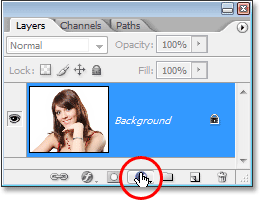
Click on the "New Adjustment Layer" icon.
Then select Hue/Saturation from the listing of adjustment layers that appears:
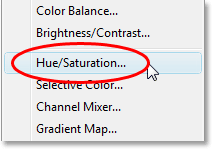
Select a "Hue/Saturation" adjustment layer.
Step 2: Select The "Colorize" Pick
When the Hue/Saturation dialog box opens, select the Colorize selection in the bottom right corner by clicking inside its checkbox:
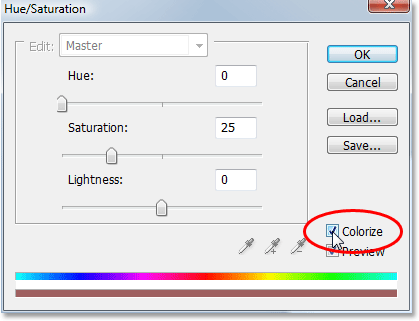
Select the "Colorize" option.
Equally soon as you select the Colorize option, you'll run across your entire image become colorized with a shade of carmine.
Pace 3: Select A New Colour For The Pilus
Drag the Hue slider left or correct to select the colour you want to use for the person's hair. For the moment, you'll be colorizing the entire image, merely we'll prepare that in the next couple of steps. Just ignore the residuum of the image for now and focus only on the hair. Once you've plant a colour you lot like, adjust the intensity of the color past dragging the Saturation slider left or correct. Dragging it to the correct gives y'all a more than saturated color, while dragging information technology to the left reduces the saturation.
Don't worry most getting the color and saturation perfect considering you tin e'er go back and change it quite easily later. I'chiliad going to set my Hue amount to about ix and increase the Saturation to around 45 for at present:
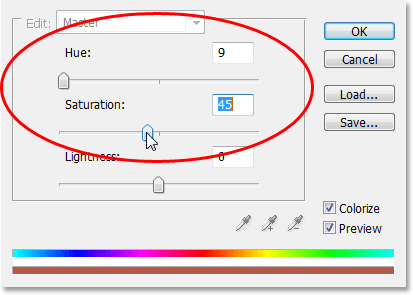
Employ the Hue slider to select a new color for the hair and adjust the intensity of the color with the Saturation slider.
Click OK when you're done to go out out of the dialog box. The adult female's pilus at present appears colorized in ruby, but so is the rest of her:

The entire image is now colorized in red.
Step 4: Fill The Hue/Saturation Layer'due south Mask With Blackness
One of the great things near adjustment layers in Photoshop is that each ane automatically comes with its own layer mask, and we're going to use it to fix the problem we currently have with our entire prototype being colorized when all we really want is for the pilus to be colorized.
To starting time with, permit's completely hide the effects of the Hue/Saturation adjustment layer by filling its layer mask with black. Since black is our current Background colour and the layer mask is already selected (Photoshop automatically selected the layer mask for us when we added the aligning layer and prepare our Foreground and Background colors to white and black, respectively), all we need to practice is employ the keyboard shortcut Ctrl+Backspace (Win) / Command+Delete (Mac) to fill the layer mask with black.
Equally soon as we practice, the colorizing effect disappears from our epitome and if nosotros look in the Layers palette, nosotros can see that the adjustment layer's thumbnail, which gives us a preview of what the layer mask looks similar, is now filled with black:
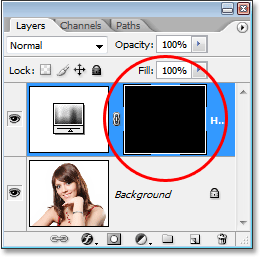
The Layers palette showing the layer mask thumbnail for the Hue/Saturation adjustment layer now filled with black.
Step 5: Select The Brush Tool
To bring back the colorizing outcome and take it applied but to the hair, all we demand to do is paint with white on our layer mask over the hair. Anywhere we pigment with white on the layer mask will reveal the furnishings of the Hue/Saturation adjustment layer, and anywhere we leave black will keep the effects subconscious. First, we need the Castor Tool, so either select it from the Tools palette or press the letter B on your keyboard to select it with the shortcut:

Select Photoshop'south Brush Tool.
We need to pigment with white on the layer mask to reveal the colorizing effect on the hair, and Photoshop has already set our Foreground color to white for us, as nosotros tin can encounter in the Foreground and Groundwork color swatches near the bottom of the Tools palette (the swatch on the left is the Foreground colour and the swatch on the right is the Background color):

Photoshop'southward Tools palette showing white as our Foreground color and blackness as our Background colour.
We also already accept our layer mask selected, and we can tell that because the layer mask thumbnail in the Layers palette has a white highlight border effectually it, as shown in the prototype for Step 4 higher up, which tells us that the mask is selected.
Step half dozen: Paint With White Over The Hair
With our Brush Tool selected, the layer mask for the Hue/Saturation adjustment layer selected, and white as our Foreground color, all we demand to do at present is paint over the hair. To apace change your brush size equally yous paint, employ the left and right bracket keys on your keyboard. The left subclass key makes the castor smaller and the right one makes information technology larger. You'll want to use a soft-edged brush, so hold downwardly your Shift key and press the left bracket key a few times to soften its edges (property Shift and pressing the right subclass key a few times makes the castor edges harder). Then simply paint over the hair to bring back the colorizing effect:
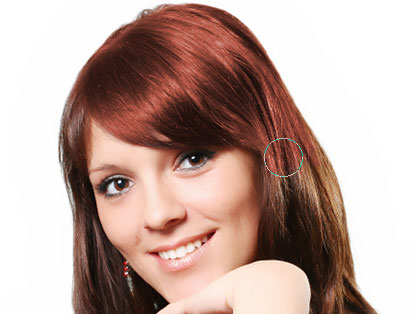
Pigment with white over the hair to reveal the colorizing effect from the Hue/Saturation aligning layer.
For trickier areas where at that place's simply loose strands of pilus, go up to the Options Bar at the pinnacle of the screen and lower the Opacity of the brush downwardly to virtually 25% or and so:

Lowering the opacity of the brush in the Options Bar.
Then lower the size of your castor and then it's no bigger than the surface area you're colorizing and pigment over it a couple of times. This way, the color won't be and so intense in those areas. Y'all may find it helps to zoom in on those areas equally well, and the easiest style to do that is to hold downwards the Ctrl (Win) / Command (Mac) key and the Spacebar and drag a selection around the expanse. Photoshop will then zoom into the area you lot selected:

Zoom into the areas of loose strands if needed and pigment over them a couple of times with a lower opacity brush.
Press Ctrl+Alt+0 (Win) / Command+Option+0 (Mac) when you're washed to zoom back out to 100%.
If yous make a mistake equally you're painting and accidentally pigment over an area y'all didn't mean to (happens all the time), but press Ten to swap your Foreground and Background colors, making black your Foreground color, and paint over the fault to undo it. Then press 10 once again to ready your Foreground color back to white and proceed painting until you have all the hair colorized:

The woman's hair is now colorized while the rest of the image is not.
We'll await at how to fine-tune the result adjacent!
Stride seven: Modify The Blend Mode To Either "Colour" Or "Soft Light"
The difficult office is washed! We've colorized the pilus while leaving the rest of the image untouched thanks to the layer mask that came with the Hue/Saturation aligning layer. Now nosotros can fine-tune the effect, and the first manner to practice that is by changing the blend way of the adjustment layer. Past default, the blend mode is set to "Normal", and it works fairly well, but let's alter it to something better. Go up to the blend way options in the superlative left corner of the Layers palette, click on the down-pointing arrow to the right of the word "Normal", and select either Colour or Soft Light from the listing:
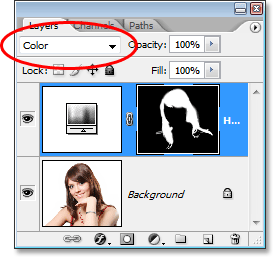
Alter the blend mode of the aligning layer to either "Color" or "Soft Light".
The "Color" blend mode gives us even more than of a colorizing issue, since information technology changes only the color of an image (when nosotros had the blend mode set to "Normal", information technology was affecting not just the color but likewise the lightness values of the hair). Here's my prototype with the alloy way of the adjustment layer prepare to "Colour":

The paradigm with the blend fashion of the adjustment layer prepare to "Color". Only the color of the hair is beingness affected. The lightness values in the pilus are not beingness affected).
The "Soft Low-cal" alloy mode gives us a more than dramatic colorizing effect because it non merely changes the color of the hair but too boosts the contrast, which I think works even better than the "Color" blend way in this case. Hither's my prototype with the blend mode set to "Soft Light":

The prototype with the blend fashion of the adjustment layer gear up to "Soft Light", giving u.s.a. a more dramatic effect.
Choose the alloy style that works all-time with your image.
Step viii: Lower The Opacity Of The Adjustment Layer If Needed
Another style to fine-tune the colorizing event is by lowering the opacity of the adjustment layer. If you discover the colour is likewise intense, just become up to the Opacity selection in the elevation right corner of the Layers palette (beyond from the blend manner option) and lower it until you're happy with the results. Hither, I've lowered the opacity of the aligning layer to l%:
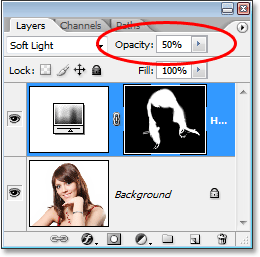
Lower the opacity of the aligning layer for a more subtle colorizing effect.
This gives me a more subtle colorizing consequence:

The paradigm after lowering the opacity of the adjustment layer.
Step ix: Edit The Hue/Saturation Settings To Change The Hair Color As Needed
At this point we're done, only if y'all need to go back and modify the hair color to something different, simply double-click on the Hue/Saturation adjustment layer's thumbnail in the Layers palette (the thumbnail on the left, not the layer mask thumbnail on the correct):
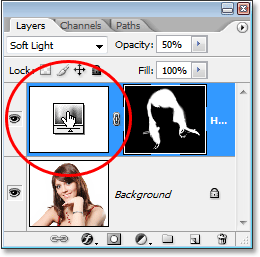
Double-click on the adjustment layer's thumbnail to edit the Hue/Saturation settings and change the hair colour.
This brings the Hue/Saturation dialog box support and nosotros can modify the hair color only by dragging the Hue slider to something different. We tin can also re-adjust the saturation of the colour with the Saturation color. Since this is an adjustment layer, we're free to make every bit many changes every bit we want without worrying about damaging our prototype. But for fun, I'll ready my Hue slider to 304 to requite her hair more of a pinkish/purple wait:
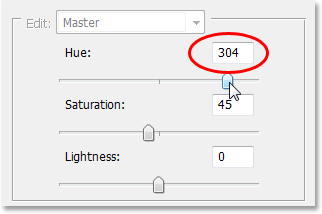
Adjust the Hue slider to modify the pilus color again.
I'm too going to ready the alloy mode of the adjustment layer back to "Color" and increase the opacity to around 75%:
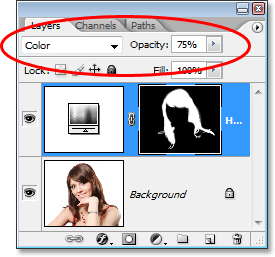
Setting the alloy way back to Color and raising the opacity to 75%.
And here's my new result:
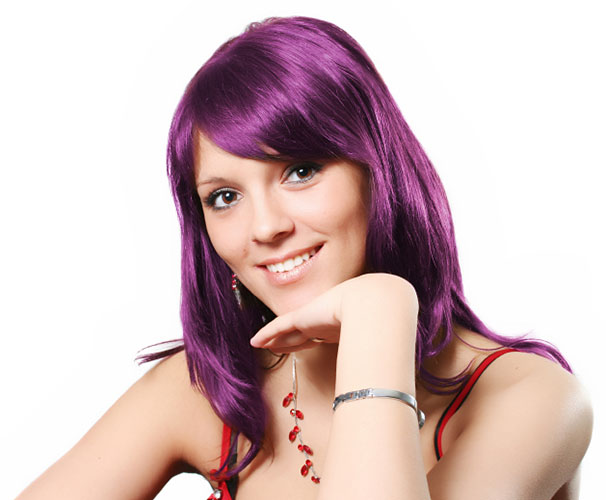
The image afterChanging the hair color and saturation, alloy mode and opacity value.
And there we have information technology! That'south how easy it is to alter someone'south hair color in Photoshop! Check out our Photo Retouching section for more Photoshop epitome editing tutorials!
Other Stuff
© 2022 Photoshop Essentials.com.
For inspiration, not duplication.
Site design by Steve Patterson.
Photoshop is a trademark of Adobe Systems Inc.
How To Change Hair Color In Photoshop Cs6 Tutorial,
Source: https://www.photoshopessentials.com/photo-editing/hair-color/
Posted by: abramswhentom.blogspot.com


0 Response to "How To Change Hair Color In Photoshop Cs6 Tutorial"
Post a Comment